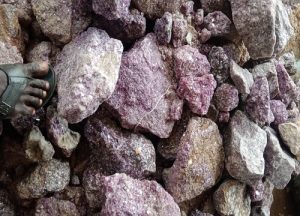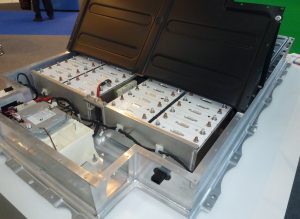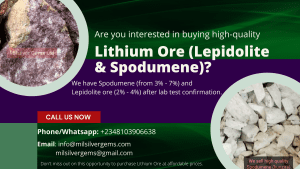Lepidolite, a lithium-containing mineral, has a wide range of industrial uses due to its unique properties. This article will explore the various industrial uses of lepidolite and its importance in different fields.
What is Lepidolite?


Lepidolite is a lilac-grey or rose-coloured member of the mica group of minerals with the chemical formula K(Li,Al)3(Al,Si,Rb)4O10(F,OH)2. It is typically found in granite pegmatites, which occur as tabular crystals or in foliated masses.
The name lepidolite was derived from the Greek words ‘lepidos’ and ‘lithos,’ which mean ‘scale stone.’ It is so named because of its scaly appearance due to the presence of flakes of mica. Lepidolite is an important source of lithium and is used extensively in industrial applications.
Physical Properties of Lepidolite
Lepidolite has unique physical properties that make it suitable for various industrial applications. It has a hardness of 2.5-3.0 on the Mohs scale, which is relatively low compared to other minerals. Its specific gravity ranges from 2.8 to 3.2.
Lepidolite has a perfect basal cleavage, which breaks easily along one plane, producing thin, flexible sheets. It has a pearly to vitreous lustre and is transparent to translucent.
Chemical Composition of Lepidolite
Lepidolite has a complex chemical composition that includes a variety of elements. The main component is potassium, aluminium, lithium, silicate, and hydroxide fluoride. Other elements that can be present in varying amounts include iron, magnesium, calcium, sodium, and fluorine.
Lepidolite is one of the few minerals that contain significant amounts of lithium, which is an essential element in various industrial uses.
Lithium Mining and Extraction from Lepidolite


Lithium is a highly reactive element that occurs naturally in small quantities in various minerals, including lepidolite. The process of mining and extracting lithium from lepidolite involves several stages, including crushing, grinding, and flotation. The extracted lithium is then further processed to produce lithium carbonate or lithium hydroxide, used in various industrial applications.
An Interesting Read: Lithium Ore Suppliers in Nigeria
Industrial Uses of Lepidolite
Lepidolite has a wide range of industrial uses due to its unique properties, including:
1. Batteries and Energy Storage


Lepidolite is a key component in the production of lithium-ion batteries, widely used in portable electronics, electric vehicles, and grid-scale energy storage systems. Lepidolite provides a stable source of lithium, which is essential for the operation of lithium-ion batteries.
2. Glass and Ceramics
Lepidolite is used in the production of glass and ceramics, where it acts as a fluxing agent, reducing the melting temperature of the materials. Lepidolite is also used as a colouring agent in ceramic production.
3. Lubricants and Greases
Lepidolite is used as a filler in lubricants and greases to improve their performance. These products also use it as a thickening agent and a flame retardant.
4. Pharmaceuticals
Lepidolite is used in the pharmaceutical industry to produce lithium-based drugs used to treat bipolar disorder, depression, and other mental health conditions. Lepidolite also has antibacterial properties and can be used in wound dressings.
5. Radiation Shielding
Lepidolite is used as a radiation shielding material due to its high lithium content and other elements that absorb and scatter ionizing radiation. It is commonly used in nuclear power plants, research facilities, and medical applications.
6. Water Treatment
Lepidolite is used in water treatment applications to remove impurities such as heavy metals, radioactive elements, and other pollutants. Lepidolite effectively absorbs these contaminants due to its high surface area and ion exchange capacity.
7. Other Uses
There are other industrial uses of lepidolite, including the production of aluminium and magnesium alloys, as a fertilizer for plants, and as a decorative stone.
Environmental and Health Considerations
The mining and processing of lepidolite can have environmental impacts, including soil erosion, water pollution, and habitat destruction. Additionally, exposure to lithium and other elements found in lepidolite can have health effects, including skin and eye irritation, respiratory problems, and neurological symptoms. Proper safety precautions and environmental regulations must be in place to minimize these risks.
Future Prospects for Lepidolite Use
Lepidolite is expected to play an increasingly vital role in the transition to clean energy and the development of new technologies. As the demand for lithium-ion batteries and other high-tech products grows, so does the demand for lepidolite. However, new sources of lithium and more efficient extraction methods will need to be developed to ensure a sustainable supply.
Important Notice
Milsilver Gems Limited is an exporter and supplier of Lithium Ores such as Spodumene and Lepidolite. You can call/ message us at +2348103906638 or click here to send a Whatsapp message.
Conclusion
Lepidolite is a versatile mineral with a wide range of industrial applications. Its unique properties, including its high lithium content, make it an essential component in many high-tech products, including lithium-ion batteries. However, the environmental and health impacts of lepidolite mining and processing must be carefully managed to ensure a sustainable future.
FAQs
1. Is lepidolite safe for use in consumer products?
- Lepidolite is safe for consumer products when proper safety precautions are followed. However, exposure to lithium and other elements found in lepidolite can have health effects, so proper safety measures must be in place.
2. How is lepidolite extracted and processed?
- Lepidolite is extracted from mines and processed using a combination of crushing, grinding, and flotation techniques. The extracted lithium is further processed to produce lithium carbonate or lithium hydroxide, used in various industrial applications.
3. What are some of the environmental impacts of lepidolite mining?
- Lepidolite mining can have environmental impacts, including soil erosion, water pollution, and habitat destruction. Proper environmental regulations and safety measures must be in place to minimize these risks.
4. How important is lepidolite in the production of lithium-ion batteries?
- Lepidolite is an essential component in the production of lithium-ion batteries, providing a stable source of lithium that is necessary for their operation.
5. What is the future of lepidolite use?
- Lepidolite is expected to play an increasingly important role in the development of new technologies and the transition to clean energy.
6. What is the future of lepidolite use?
- Lepidolite is expected to play an increasingly important role in the development of new technologies and the transition to clean energy. However, new sources of lithium and more efficient extraction methods will need to be developed to ensure a sustainable supply.
7. What are some of the uses of lepidolite beyond lithium-ion batteries?
- Lepidolite has a wide range of industrial applications, including lubricants and greases, pharmaceuticals, radiation shielding, water treatment, and more.
8. Is lepidolite a rare mineral?
- Lepidolite is relatively common and is found in many parts of the world. However, high-quality deposits with a high lithium content are rare.
9. Are there any alternative materials to lepidolite for lithium extraction?
- Yes, other materials such as spodumene, petalite, and amblygonite can also be used to extract lithium.
10. How can the environmental impact of lepidolite mining be minimized?
- Proper environmental regulations, safety measures, and sustainable mining practices can help to minimize the environmental impact of lepidolite mining.
11. Can lepidolite be recycled?
- Yes, lepidolite can be recycled and reused in various industrial applications, including the production of new lithium-ion batteries.


